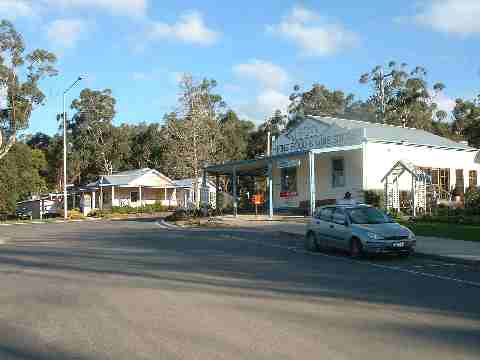| Name | Harry William PROSSER |
| Birth | 24 Jun 1922, Blackwood Forrest Age: 82 |
| Father | Harry Hutson PROSSER (1895-1964) |
| Mother | Isabella Wood HAY (1898-1993) |
| 1 | Marjorie ALEXANDER |
| Birth | 28 Mar 1925 Age: 79 |
| Children: | Geoffrey (1952-) |
| Leon (1957-) | |
| Beverley (1959-) |
Occupation: Dairy farmer
Koonwarra, Victoria

Served as a Leading Aircraftman in the RAAF during World War 2
Posting included:
No1 Recruitment Depot (Laverton)
S.T.T. School of Technical Training Adelaide
Equipment Training School (Ascot Vale, Showgrounds) - Dec 1941
5 EFT Flight Maintenance- Elementary Flight School (Narromine NSW) - April 1942
Narromine Aerodrome was handed over to the RAAF in July 1940 for the establishment of No.5 Elementary Flying Training School. One of a dozen such schools around Australia forming part of the Empire Air Training Scheme, the school graduated 2,850 pilots during its four-year stay.
1ES Engineering School (Ascot Vale, Showgrounds) - Sept 1942
2 AD Aircraft Depot (Richmond) March - 1943
Base Torpedo Unit (Nowra) - Nov 1943
Over 450 students graduated as Fitter Torpedo and Aircraft Hand (Torpedo) from the base Torpedo Unit at Nowra between May 1942 and June 1944. Although aircrew training was undertaken at Nowra, it was not until June 1943 that a dedicated Operational Training Unit was formed. Three squadrons (Nos. 7, 8 and 100) were converted to torpedo bomber units, but No. 7 never flew in the role. At least 13 per cent of the 145 pilots and their crews who attended courses were subsequently posted to other than torpedo bomber units. Even where trained aircrew went to one of the two operational torpedo bombing units, only 30 per cent actually participated in one or more missions.

Nowra Classroom Base Torpedo Unit
1 ITS - Initial Training School (Somers) - Feb 1944
No 7 Aircraft Depot (Tocumwal) - April 1944
Tocumwal Airfield
A WW2 site, established by the USAAF (who called it 'McIntyre Field') on the NSW/Victoria border (Newell Highway). Once about 25 miles square. Taken over by the RAAF in 1942, and had at one stage 4,500 RAAF persons, 400 WAAF persons, 54 Liberators, 11 Vultee Vengeances, five Kittyhawks and an Airspeed Oxford. It was also a vast storage and repair depot with aircraft such as Avro Anson, Airacobra, Beaufort, Boeing, Boomerang, Dakota, Hudson, Lancaster, Lincoln, Meteor, Mosquito, Mustang, Spitfire, Beaufighter, Vampire, Winjeel and Wirraway.
| Short History of the War in the Pacific 1944 |
|---|
|
January |
June 1945 Harry ---> Port Moresby - Madang - New Guinea
40 Squadron
Equipped with six Sunderland flying boats 40 Squadron formed in Queensland on 31 March 1944. Initial operations saw the squadron operating between Townsville and New Guinea, ferrying supplies and passengers. In July 1944, 40 Squadron was relocated to Port Moresby, where it continued its transport duties to mainland Australia as well as other island destinations.During one mission in March 1945, a 40 Squadron Sunderland located survivors from a crashed Dakota. The Sunderland crew dropped a dingy and medical supplies to the survivors and remained on station to guide a naval trawler to pick up the Dakota's crew.
By mid-1945, four Martin Mariner flying boats were added to the squadrons inventory, operating alongside the Sunderlands. With the cessation of hostilities, 40 Squadron repatriated Australian personnel to the mainland prior to moving to New South Wales in March 1946.
Catalinas soon replaced the Mariners, however, operations were rapidly scaled down and on the 19 June 1946, 40 Squadron was disbanded.
February 1946 Harry ------> end of March 1946
33 Squadron
Initially equipped with Empire flying boats, 33 Squadron formed at Townsville in February 1942. Shortly after, the squadrons inventory was supplemented with a variety of lighter aircraft including Dragons, Ansons, Tiger Moths and Vigilants.After moving to Port Moresby in January 1943, 33 Squadron was heavily involved in airlifting vital supplies to Australian forces in the jungles of New Guinea. Many freight runs to Myola and Kokoda were made - where even the diminutive Tiger Moths were pressed into service, delivering 77 kilograms of cargo each trip!
In October 1943, 33 Squadron was re-equipped with Dakotas and operated this type on transport duties until the end of the war. After Japan's surrender, 33 Squadron ferried POWs and Allied troops from their remote locations back to Australia, before disbanding in May 1946.